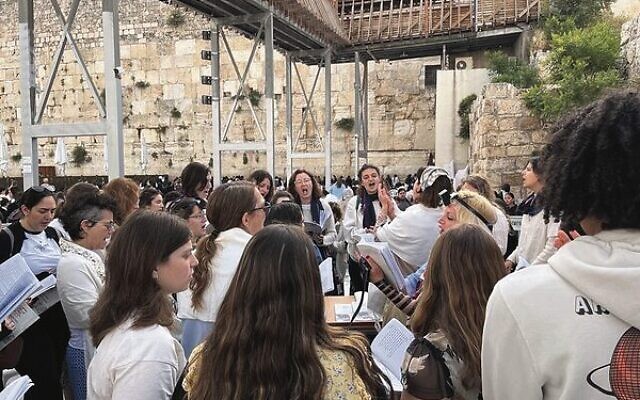The conflict at the Kotel goes on
The women have been corralled to a corner of the women's section, far from the wall. They are approximately 60, and huddle together in a circle, both for safety and to hear each other sing.
The frenzied flight of the swallows of the Kotel is choreographed by the level of noise and activity coming from the worshippers below them. Today, Rosh Chodesh Sivan, the dance is particularly frenetic.
Rosh Chodesh at the wall has become a battleground between the Women of the Wall and the Charedi-dominated Western Wall Foundation – a quasi-governmental authority led by an ultra-Orthodox rabbi who is appointed for life. The authority segregated the men and women, and demands women pray in complete silence, with no group prayer and no Torah scrolls.
Despite a Jerusalem District Court determination in 2013, after over 50 arrests and detentions, that the Women of the Wall have the right to pray in peace and do not pose a “threat”, the rabbi of the Kotel implemented regulations preventing women from accessing Torah scrolls, despite there being over 700 in the men’s section. He also banned all “outside” Torah scrolls from being brought in.
The plan for a pluralistic section not administered by the rabbi of the Kotel, despite government approval, was rescinded when the ultra-Orthodox parties threatened to leave the government of the time. There is a small temporary wooden platform, removed from but facing the wall, south of the main plaza at Robinson’s Arch. It falls well short of the needs of worshippers.
My partner Sandra and I join the Women of the Wall on this Rosh Chodesh. Arriving at the wall, security is extra intense and we are body checked. They are checking to ensure nobody is trying to bring in an outside Torah. Sure enough, our small Torah scroll is discovered and confiscated. Expecting this, the women have an excerpt from today’s parsha copied onto a sheet which is not detected.
Metal security barriers are set up to herd us, like condemned sheep, towards designated areas. There is pushing and a constant barrage of instructions, including through megaphones. The Wall Authority guards are clearly not there to protect us, but rather to intimidate. The women are separated from the men. I am sent to a small barricaded section behind the women’s prayer section. We can see the women but it is hard to hear because we are surrounded by Charedim, mainly young, many of them bussed in to harass us. They are abusive, calling us “dogs” and telling us we are not Jews. They swear, whistle and chant “bushah” (shame).
I met a 19-year-old gap year student who identifies as a halachic egalitarian, who has been coming regularly to support the women. He tells me, “I have received plenty of abuse. They have told me God hates me; that I caused the Holocaust. It’s hurtful, but it puts a fire in your belly!” As I am interviewing him, I am shoved and a young bocher tries to cover the lens of my camera.
The women have been corralled to a corner of the women’s section, far from the wall. They are approximately 60, and huddle together in a circle, both for safety and to hear each other sing. The din from the Charedi protesters is so great, they recently created a choir, so that by singing together in unison they can hear each other. Behind the metal barriers, they are protected from the worst of the abuse from women and young girls. Sandra is given an aliyah to the Torah.
“It was such an empowering experience. I was both emotional and proud to be with these women and to be called to the Torah at the Kotel,” she said.
I asked her if she felt safe: “I didn’t feel safe when we were being pushed by the Wall Authority guards, but standing there, surrounded by these brave and determined women, I felt very safe.”
The service complete, we begin the logistical exercise of exiting in safety. We are again surrounded by guards who act as a barrier between us and the abusive Charedi protesters who are intent on chasing us out. At one point I look up and a young Charedi girl spits at us. We retrieve our precious Torah scroll, and board the awaiting buses.
The experience was both uplifting and demeaning. Lesley Sachs, vice-president of the Israel Movement for Progressive Judaism and a previous CEO of Women of the Wall tells me, “The people at the current protests against the Judicial coup and the recent ultra-Orthodox centric budget are making the connection between their rights as women, or secular Jews, or LGBTQI+ or Arabs and even as Likud supporters, and our battles for recognition at the Kotel. Citizens of Israel have had enough, and are looking for a paradigm change away from ultra-Orthodox hegemony over their lives.”
Michah Eshet, who leads a group of soldiers who conquered the Old City in the 1967 war and supports the women adds, “We are the liberators of the Wall. You (Women of the Wall) are the modern liberators of the Wall.”
At the Kotel, the swallows circle, the worshippers chant, the ancient stones bear witness, and the battle for women’s rights to express their Judaism there goes on.
Danny Hochberg is a member of the Sydney Jewish community.


comments